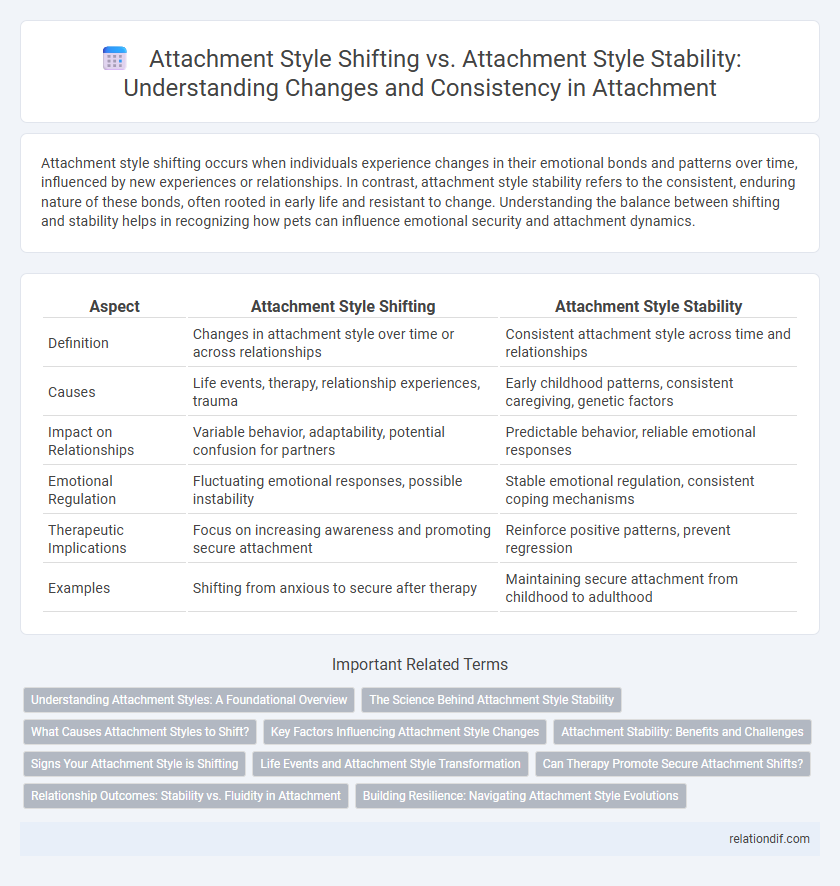Attachment style shifting occurs when individuals experience changes in their emotional bonds and patterns over time, influenced by new experiences or relationships. In contrast, attachment style stability refers to the consistent, enduring nature of these bonds, often rooted in early life and resistant to change. Understanding the balance between shifting and stability helps in recognizing how pets can influence emotional security and attachment dynamics.
Table of Comparison
| Aspect | Attachment Style Shifting | Attachment Style Stability |
|---|---|---|
| Definition | Changes in attachment style over time or across relationships | Consistent attachment style across time and relationships |
| Causes | Life events, therapy, relationship experiences, trauma | Early childhood patterns, consistent caregiving, genetic factors |
| Impact on Relationships | Variable behavior, adaptability, potential confusion for partners | Predictable behavior, reliable emotional responses |
| Emotional Regulation | Fluctuating emotional responses, possible instability | Stable emotional regulation, consistent coping mechanisms |
| Therapeutic Implications | Focus on increasing awareness and promoting secure attachment | Reinforce positive patterns, prevent regression |
| Examples | Shifting from anxious to secure after therapy | Maintaining secure attachment from childhood to adulthood |
Understanding Attachment Styles: A Foundational Overview
Attachment style shifting refers to the changes in an individual's attachment patterns over time, influenced by experiences and relationships, while attachment style stability emphasizes the persistence of early-formed attachment behaviors throughout life. Research in attachment theory highlights that secure, anxious, avoidant, and disorganized attachment styles can exhibit varying degrees of flexibility or consistency depending on environmental factors and personal growth. Understanding the dynamic interplay between stability and plasticity in attachment styles is essential for comprehending emotional regulation and relationship functioning.
The Science Behind Attachment Style Stability
Attachment style stability is influenced by early caregiver interactions that shape neural pathways regulating emotional responses. Research in developmental psychology and neuroscience reveals that while attachment styles exhibit relative stability over time, significant life experiences and therapeutic interventions can shift internal working models. Longitudinal studies indicate that the adult attachment system retains a degree of plasticity, allowing for adaptive changes in attachment behavior despite foundational stability established in childhood.
What Causes Attachment Styles to Shift?
Attachment styles can shift due to significant life experiences such as trauma, therapy, or changes in close relationships that challenge existing relational patterns. Neuroplasticity in the brain enables individuals to develop new attachment behaviors when exposed to consistent, secure interactions or emotional support. Fluctuations in mental health and increased self-awareness also contribute to the evolution of attachment styles over time.
Key Factors Influencing Attachment Style Changes
Attachment style changes are influenced primarily by significant life events such as trauma, relationships, and therapy, which can reshape an individual's internal working models. Consistent caregiver responsiveness and emotional regulation skills foster attachment style stability, reinforcing secure attachments over time. Neurobiological factors, including brain plasticity and stress hormone regulation, also play a critical role in the dynamic nature of attachment style development and modification.
Attachment Stability: Benefits and Challenges
Attachment stability fosters secure emotional bonds by providing consistency and predictability in relationships, which supports psychological resilience and healthy interpersonal development. However, rigid attachment patterns can limit adaptability to changing relational contexts, potentially hindering personal growth and responsiveness to new emotional needs. Understanding the benefits and challenges of attachment stability informs therapeutic approaches aimed at enhancing relational flexibility while preserving emotional security.
Signs Your Attachment Style is Shifting
Changes in behavior such as increased openness in emotional expression, reduced fear of abandonment, and improved trust in relationships can indicate that your attachment style is shifting. Recognizing patterns like seeking healthier connections, enhanced communication, and greater comfort with intimacy often signal attachment style evolution. Monitoring these signs helps distinguish between temporary fluctuations and genuine attachment style stability or transformation.
Life Events and Attachment Style Transformation
Life events such as trauma, relationship changes, or significant personal growth often trigger shifts in attachment styles, demonstrating the plasticity of attachment patterns over time. Research highlights that while early attachment styles provide a baseline, transformative life experiences can lead to a stable reorganization of attachment behaviors and expectations. Understanding the mechanisms behind attachment style transformation informs therapeutic approaches aimed at fostering secure attachment despite prior insecure attachments.
Can Therapy Promote Secure Attachment Shifts?
Therapeutic interventions can significantly promote secure attachment shifts by addressing maladaptive patterns and fostering emotional regulation and trust. Evidence from attachment-based therapies, such as Emotionally Focused Therapy (EFT) and Attachment-Based Psychotherapy, demonstrates measurable improvements in attachment security over time. Neurobiological research supports that therapy facilitates changes in brain areas related to attachment, indicating that attachment styles exhibit a degree of plasticity rather than rigid stability.
Relationship Outcomes: Stability vs. Fluidity in Attachment
Attachment style stability fosters consistent emotional regulation and secure relationship patterns, enhancing long-term relationship satisfaction and trust. In contrast, attachment style shifting often correlates with relationship instability, increased conflict, and lower overall relationship quality due to fluctuating emotional needs and insecurities. Research indicates that while some degree of attachment fluidity allows adaptability, excessive shifts in attachment style can undermine relationship cohesion and emotional intimacy.
Building Resilience: Navigating Attachment Style Evolutions
Attachment style shifting reflects an individual's capacity to adapt emotional bonds in response to life experiences, promoting resilience through flexibility and self-awareness. Stability in attachment style offers a consistent framework for emotional regulation and relational expectations, fostering a secure base in interpersonal connections. Building resilience involves integrating both attachment style stability and adaptability, enabling effective navigation of evolving relational dynamics while maintaining core emotional security.
Attachment style shifting vs attachment style stability Infographic

 relationdif.com
relationdif.com